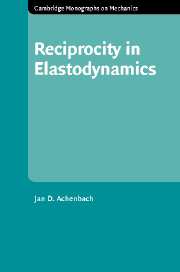Book contents
- Frontmatter
- Contents
- Preface
- 1 Introduction
- 2 Some elastodynamic theory
- 3 Wave motion in an unbounded elastic solid
- 4 Reciprocity in acoustics
- 5 Reciprocity in one-dimensional elastodynamics
- 6 Reciprocity in two- and three-dimensional elastodynamics
- 7 Wave motion guided by a carrier wave
- 8 Computation of surface waves by reciprocity considerations
- 9 Reciprocity considerations for an elastic layer
- 10 Forced motion of an elastic layer
- 11 Integral representations and integral equations
- 12 Scattering in waveguides and bounded bodies
- 13 Reciprocity for coupled acousto-elastic systems
- 14 Reciprocity for piezoelectric systems
- References
- Index of cited names
- Subject index
9 - Reciprocity considerations for an elastic layer
Published online by Cambridge University Press: 10 December 2009
- Frontmatter
- Contents
- Preface
- 1 Introduction
- 2 Some elastodynamic theory
- 3 Wave motion in an unbounded elastic solid
- 4 Reciprocity in acoustics
- 5 Reciprocity in one-dimensional elastodynamics
- 6 Reciprocity in two- and three-dimensional elastodynamics
- 7 Wave motion guided by a carrier wave
- 8 Computation of surface waves by reciprocity considerations
- 9 Reciprocity considerations for an elastic layer
- 10 Forced motion of an elastic layer
- 11 Integral representations and integral equations
- 12 Scattering in waveguides and bounded bodies
- 13 Reciprocity for coupled acousto-elastic systems
- 14 Reciprocity for piezoelectric systems
- References
- Index of cited names
- Subject index
Summary
Introduction
In Chapter 7 it was shown that for time-harmonic wave motion there is an infinite number of wave modes that can propagate in a linearly elastic layer. These modes correspond to standing waves across the thickness of the layer and propagation along the layer. It was shown that for the isotropic case the standing waves consist of thickness-stretch and thickness-shear motions carried by the wave propagating along the layer, the carrier wave. The carrier wave acts like a membrane wave in the mid-plane of the layer in that it is governed by a reduced wave equation in that plane. As was discussed earlier, the carrier wave may be a plane, cylindrical or any other kind of wave as long as it is a solution of the membrane equation. The important point is that the thickness motions remain the same; they are independent of the form of the carrier wave. For a specific real-valued frequency a wavenumber-like quantity is the solution to the Rayleigh–Lamb frequency equations. The curves that represent the solution for the real, imaginary or complex-valued wavenumber versus the frequency define the frequency spectrum. Each line of frequency versus wavenumber is called a branch and defines a mode of wave propagation in the layer. The modes can be separated into symmetric and antisymmetric modes. For a detailed discussion of the frequency spectrum of Lamb waves we refer to Mindlin (1960) or Achenbach (1973).
The modes are independent from each other in that they satisfy orthogonality relations.
- Type
- Chapter
- Information
- Reciprocity in Elastodynamics , pp. 145 - 156Publisher: Cambridge University PressPrint publication year: 2004

